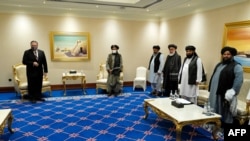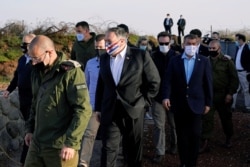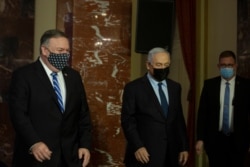U.S. Secretary of State Mike Pompeo said Saturday that the United States would “sit on the side and help where we can” as he met in Qatar with Afghan government negotiators amid signs of progress to reach a peace agreement with the Taliban.
“I would be most interested in getting your thoughts on how we can increase the probability of a successful outcome,” reporters heard Pompeo telling the Afghan negotiating team.
The outgoing top U.S. diplomat also met with Taliban negotiators in Doha as the U.S. speeds up its withdrawal of U.S. troops from Afghanistan after invading the country in 2001.
Pompeo and the Taliban negotiating team discussed how to reduce violence in the war-torn country, according to a statement from State Department spokesperson Cale Brown. Pompeo also “encouraged expedited discussions” to develop a “political road map” leading to a permanent cease-fire in Afghanistan.
The Taliban and Afghanistan’s government began negotiating for the first time in September in Doha after the Taliban and the U.S. signed a deal in February. The U.S. agreed to withdraw all foreign troops in exchange for security guarantees and a Taliban commitment to begin negotiations.
Pompeo met earlier Saturday in Doha with United Arab Emirates Crown Prince Mohammed bin Zayed Al Nahyan and discussed the UAE’s normalization of ties with Israel, countering Iran’s influence in the Middle East, and the need to reach a political solution to achieve peace in Yemen, the State Department said.
The secretary of state also met in Doha with Qatar’s ruler, Emir Sheikh Tamim bin Hamad Al-Thani, the deputy prime minister and the foreign minister.
Pompeo thanked Al-Thani for Qatar’s military partnership at the Al Udeid Air Base, initiatives to counter terrorism financing, and the ongoing support for Afghan peace negotiations. They also discussed the need for working together to confront threats to stability in the region to further counter Iran, Brown said.
Pompeo’s visit to Qatar is the latest stop on a 10-day, seven nation tour of the Middle East and Europe as outgoing U.S. President Donald Trump shores up late-term priorities.
Controversial West Bank visit
The tour has also taken Pompeo to Israel, where he visited an Israeli settlement Thursday in the occupied West Bank, a first by a high-ranking U.S. official after announcing a new initiative to halt a Palestinian-led movement to internationally boycott Israel.
A State Department official told reporters, who were not allowed to accompany Pompeo, that the top U.S. diplomat went to the Psagot Winery outside Jerusalem.
Pompeo also made a similar visit to the Golan Heights, an area Israel has occupied since capturing it from Syria in the 1967 war.
Israel has built scores of settlements in the West Bank, territory the Palestinians want for their future state. Most of the international community views the settlements as a violation of international law and a barrier in reaching a peace agreement with the Palestinians. Israel’s annexation of the Golan Heights has also not been recognized internationally. U.S. President Donald Trump signed a proclamation recognizing Israeli sovereignty over the territory last year.
Earlier, Pompeo said the United States will consider the movement advocating for boycotting and divesting from Israel to be anti-Semitic.
Supporters of the Palestinian-led Boycott, Divestment and Sanctions movement say it is a form of protest against Israeli occupation and is modeled after the 1980s boycott that pressured South Africa to end apartheid.
Human Rights Watch condemned Pompeo’s announcement, saying, “The Trump administration has no business trying to tar groups because they back boycotts.” The rights group noted that boycotts had been used throughout U.S. history to advance social justice.
After meeting Thursday with Netanyahu, Pompeo said the U.S. will require imports from the West Bank settlements to be labeled “Made in Israel” or “Product of Israel.” The requirement eliminates the distinction between products made in Israel and those made in occupied territory.
Netanyahu and Pompeo congratulated each other for steps taken during President Donald Trump’s administration that went against prior U.S. policy, including recognition of Jerusalem as Israel’s capital, the movement of the U.S. embassy there, and no longer viewing Israeli settlements in the occupied West Bank as unlawful.
Netanyahu, who said Thursday the U.S.-Israel relationship reached “unprecedented heights” during the Trump administration, also highlighted Israel’s recent agreements normalizing relations with Bahrain, Sudan and the United Arab Emirates.
Neither Netanyahu nor Pompeo mentioned the U.S. election. Like Trump, Pompeo has not acknowledged former Vice President Joe Biden's Nov. 3 presidential victory. Earlier this week, Netanyahu congratulated Biden and referred to him as the president-elect in an official statement.








